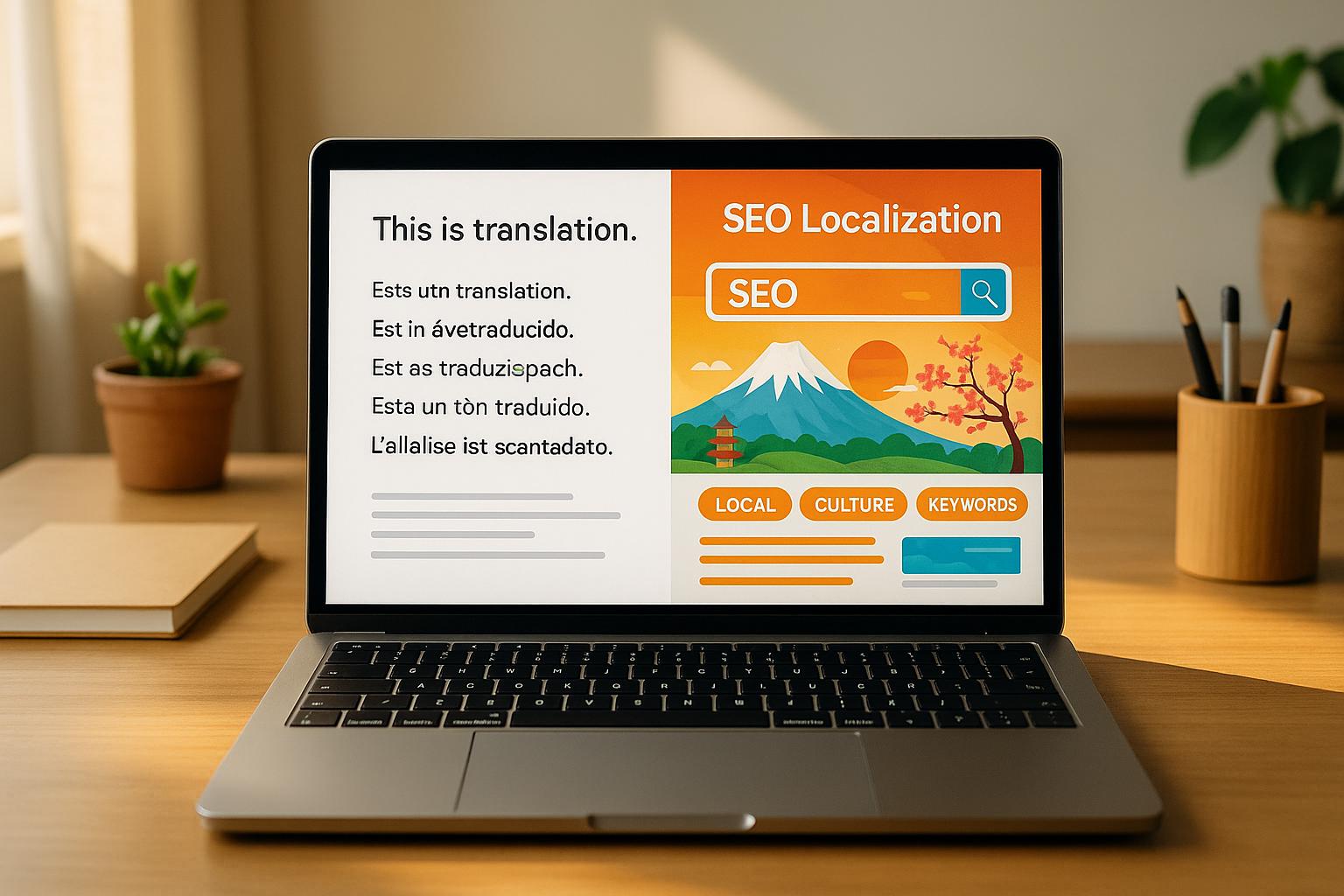Want to expand globally? You’ll need to decide between SEO localization and SEO translation. Both aim to boost your visibility online, but they’re not the same.
- SEO translation converts content into a new language while keeping keywords and SEO elements intact. It’s faster and works well for technical or informational content.
- SEO localization adapts content for local habits, preferences, and search behavior. It’s more resource-intensive but builds stronger connections with local audiences.
Key takeaway: Use translation for efficiency and localization for deeper engagement. Often, combining both is the best strategy – translate first to test the market, then localize key pages to resonate better.
Stop Doing SEO Translation. Start Doing SEO Localization. – Maria Scheibengraf
What is SEO Translation?
SEO translation involves converting content from one language to another while keeping its meaning intact and preserving essential SEO elements like keywords, meta descriptions, and structure. It’s not just about word-for-word translation; it’s about ensuring the content resonates with the target audience and aligns with how search engines rank content in different languages.
Think of SEO translation as creating a bridge between languages. The goal is to deliver the same message, maintain the original structure, and target keywords that people are actively searching for in the new language.
Main Features of SEO Translation
Preserving keywords is a cornerstone of SEO translation. Translators need to research and identify equivalent keywords in the target language rather than simply translating them. This involves analyzing search volume, competition, and user intent to ensure the content ranks well in the new market.
Maintaining technical elements ensures that SEO components like title tags, meta descriptions, alt text, and URL structures are accurately adapted. These elements must stay within character limits and remain optimized for search engines.
Consistency in content structure is crucial. The translated content should retain the original hierarchy of headings and internal links, which helps search engines understand and rank the page effectively.
Aligning with search intent means adjusting content to match how users in the target market search for information. This might involve tweaking phrasing or adding details that are more relevant to local audiences.
Common Use Cases
SEO translation is particularly valuable for various types of content, including technical documentation, blogs, product descriptions, and legal materials.
- Technical documentation: Manuals, software guides, and product specifications benefit greatly from SEO translation. These require precise language that maintains technical accuracy while incorporating relevant keywords for the target language.
- Informational blog content: Topics like how-to guides, educational pieces, and industry insights often translate well without major adjustments. These types of content retain their SEO value as long as the subject matter is universally applicable.
- Product descriptions: For e-commerce, SEO translation ensures that product details are both accurate and optimized for search engines in the target market. The focus is on highlighting features and benefits while using locally relevant keywords.
- Legal and compliance content: Documents like terms of service, privacy policies, and regulatory information require careful translation to ensure they’re accurate and easily discoverable by users searching for specific legal terms.
Requirements for Effective SEO Translation
To achieve successful SEO translation, specific skills and processes are essential.
- Bilingual SEO knowledge: Translators must understand how search engines operate in both the source and target languages. This includes knowing the ranking factors and user behaviors unique to each market.
- Keyword research expertise: Effective translation requires in-depth keyword research in the target language. Translators need access to tools that reveal local search trends and show how users phrase their queries.
- Subject matter expertise: Translators working on specialized content, like medical or legal documents, must have relevant expertise to ensure accuracy and credibility in the target language.
- Technical SEO skills: Translators should understand how to handle elements like URL structures, metadata, and internal linking. They need to ensure these technical aspects remain optimized and functional after translation.
- Quality assurance: A thorough review process is essential. This includes checking the linguistic accuracy of the translation and validating the SEO elements to ensure the content performs well in the target market. For instance, translated keywords should be tested to confirm their relevance and effectiveness.
What is SEO Localization?
SEO localization is all about tailoring content to fit the cultural and behavioral norms of a specific region. Unlike simple translation, which focuses on converting text from one language to another, localization creates a seamless, native experience that feels like it was made specifically for the local audience.
This process involves understanding how people in different areas search for information, what cultural references resonate with them, and how they prefer to engage with content. Everything from visuals to payment options is adapted, ensuring users feel the content is crafted for their market – not just repurposed from another.
Localizing content means much more than just swapping out words. It includes using regional slang, referencing local events, aligning with local business practices, and adjusting the tone to reflect cultural norms. Let’s dive into the key features that make SEO localization so effective.
Main Features of SEO Localization
To truly connect with a local audience, SEO localization relies on several essential components:
- Cultural adaptation: This is the foundation of SEO localization. It requires understanding local customs, holidays, social norms, and preferred communication styles. Even if the language is the same, what works in one culture might completely miss the mark in another.
- Regional keyword optimization: Instead of directly translating keywords, this involves researching how locals actually search online. People in different regions often use unique terms for the same ideas, and search behavior is deeply influenced by cultural nuances.
- Design adaptation: Images, colors, and layouts are adjusted to match local preferences. For example, a color that signifies celebration in one culture might have a negative connotation in another. The goal is to create a design that feels familiar and appealing to the target audience.
- Technical localization: This includes formatting currency symbols, dates, numbers, and measurement units to meet local expectations. For example, U.S. audiences expect prices in dollars, dates in MM/DD/YYYY format, and measurements in feet and inches.
- Local market integration: This goes beyond the content itself, incorporating local business hours, shipping methods, customer support options, and compliance with regional regulations. These details build trust and make the experience feel authentic.
Common Use Cases
SEO localization is especially valuable for businesses looking to connect with local audiences and compete with native players in the market. Here are some scenarios where it’s most impactful:
- E-commerce expansion: When online stores enter new markets, they need to adapt everything from product descriptions to payment methods and shipping details. This might include displaying prices in the local currency, offering region-specific payment options, and tailoring product offerings to local tastes and regulations.
- Marketing campaigns and promotions: Successful campaigns require deep localization to resonate with the target audience. This means aligning strategies with local shopping habits, seasonal trends, and cultural events to ensure maximum impact.
- Service-based businesses: Expanding services to new regions means adapting descriptions to meet local needs, showcasing testimonials from local customers, and addressing region-specific challenges that the service solves.
- Content marketing and thought leadership: To build credibility in new markets, content must reflect local trends, reference regional statistics, and tackle market-specific issues. This helps establish a genuine connection with the audience.
Requirements for Effective SEO Localization
Achieving successful SEO localization requires more than just technical know-how. It demands a combination of cultural understanding, research, and ongoing effort:
- Deep cultural fluency: This goes beyond language proficiency. It’s about understanding the social dynamics, consumer behavior, and sensitivities of the target market. Having team members with insider knowledge of the region is invaluable.
- Local market research: Decisions should be informed by real data, not assumptions. This includes analyzing local search behaviors, studying regional competitors, and mapping out customer journeys specific to the area.
- Regional SEO expertise: Search engines function differently across markets, and user interactions with search results vary. Adapting to these patterns is crucial for effective localization.
- User experience awareness: A great user experience can mean different things in different cultures. From preferred website layouts to content formats, understanding these preferences ensures the site feels intuitive and engaging.
- Ongoing updates: Local markets are constantly evolving. Search trends shift, cultural references lose relevance, and new competitors emerge. Regularly refreshing localized content is essential to maintain its effectiveness.
Main Differences Between SEO Localization and Translation
Both SEO localization and SEO translation aim to help businesses connect with international audiences, but they serve distinct purposes. SEO translation focuses on making content accessible and searchable, while SEO localization builds a deeper connection by aligning with cultural and emotional nuances. As Weglot puts it:
"SEO translation aims to improve searchability, while SEO localization aims to improve searchability and make you more relatable to your audience."
These differences influence every step, from keyword research to execution, and shape your broader SEO strategy. Let’s explore how they compare.
Comparison Table
| Aspect | SEO Translation | SEO Localization |
|---|---|---|
| Objective | Provide accurate, searchable information | Establish cultural and emotional relevance while improving searchability |
| Approach | Converts text while preserving meaning and keyword integrity | Integrates market research, audience behavior, and cultural norms |
| Keyword Strategy | Adjusts keywords to fit the target language; often a direct translation with minor tweaks | Develops keywords based on local search intent and behavior; requires fresh research for each market |
| Cultural Adaptation | Minimal or none | Incorporates local idioms, preferences, and visual elements to align with cultural nuances |
| Content Types | Works best for technical or informational content like manuals, software documentation, and educational blogs | Ideal for marketing campaigns, e-commerce, lifestyle, entertainment, and content requiring cultural resonance |
| Required Expertise | SEO-savvy translators focused on keywords, titles, and tags | Native speakers or local experts with deep cultural and market knowledge |
| Cost/Time Investment | Quicker and more affordable | Demands more time, effort, and resources |
How These Differences Impact SEO Strategy
The choice between SEO translation and localization has practical implications for your overall strategy:
- Budget and Timeline: If you’re entering a new market with limited resources, SEO translation offers a faster and more affordable option. However, this comes at the cost of deeper engagement with local audiences, which localization can achieve.
- Content Performance: Translated content is effective for straightforward, factual searches. On the other hand, localized content thrives in competitive spaces where emotional resonance and cultural familiarity drive user decisions.
- Team Expertise: Translators with SEO knowledge can handle SEO translation, but localization demands a broader team. You’ll need cultural experts, native speakers, and market researchers to capture regional nuances effectively.
- Market Positioning: Translation positions your brand as a global entity offering consistent value across regions. Localization, however, makes your brand feel like an integral part of the local market, showing that you understand and cater to specific regional needs.
- Competitive Landscape: In markets dominated by local businesses with a strong grasp of cultural preferences, localization can give you the edge to stand out. But in markets where global brands succeed with translated content, translation might suffice as an initial strategy.
Each approach has its strengths, and the right choice depends on your goals, audience, and market conditions.
sbb-itb-880d5b6
When to Use SEO Localization vs. Translation
Deciding between SEO localization and translation depends on your goals, target audience, and the type of content you’re working with. Making the right choice can help you allocate resources wisely and improve your online presence. Here’s a closer look at when to use each approach and how they can work together.
When to Opt for SEO Translation
SEO translation works best when precision and clarity are your priorities, without the need to adapt to cultural differences. It’s ideal for content like technical documentation, user manuals, legal notices, and educational materials. This method is also a great way to quickly test new markets and gauge potential interest.
When to Opt for SEO Localization
SEO localization is the way to go when cultural context and local preferences are crucial for connecting with your audience. This approach adjusts your messaging to align with local search habits, consumer expectations, and cultural nuances. It’s particularly effective for marketing materials, product descriptions, customer reviews, and service-related content where engagement and conversions are key.
How to Combine Both Approaches
You don’t have to choose one over the other – these strategies can complement each other. Start by translating core content to establish your presence quickly. Then, focus on localizing high-impact pages like your homepage or marketing campaigns to resonate more deeply with local audiences and drive better results.
Conclusion
Understanding the distinction between translation and SEO localization is crucial for shaping an effective international SEO strategy. While translation focuses on making content clear and accessible for a global audience, SEO localization goes a step further, tailoring content to align with local culture, emotions, and preferences by incorporating regional idioms, tastes, and even visual elements. These approaches serve different purposes, as highlighted earlier.
Translation is a faster, more efficient option for standard content, whereas localization – though requiring more resources – creates stronger connections with local audiences, driving engagement and fostering trust in your brand.
The choice depends on your objectives. If your goal is broad access and efficiency, translation is the way to go. For building a deeper cultural connection with your audience, localization is the better option.
In 2024, Weglot adjusted "auténticos platos de pasta y deliciosos vinos" to "auténtica comida italiana" for Spanish-speaking users. This simple change led to increased search volumes, better visibility, higher engagement, and improved conversions.
A successful international SEO strategy often blends both translation and localization. Start with translation to establish your presence quickly, then localize key pages to create a more meaningful connection with target markets. Aligning your approach with your audience’s expectations and your business goals will enhance your online visibility and drive stronger user engagement.
FAQs
When should my business focus on SEO localization instead of SEO translation?
SEO Localization vs. SEO Translation
When aiming to connect with a specific local audience, SEO localization is the way to go. This method tailors your content to align with the language nuances, cultural preferences, and search habits of that particular region. The result? Content that feels authentic and relevant, helping you build trust and foster engagement with users in that area.
On the flip side, SEO translation works best when your priority is simply making your content available in multiple languages without diving deep into cultural customization. It’s a straightforward approach to boost your visibility in various language markets while keeping the original message intact.
What mistakes should I avoid when using SEO localization?
Avoid These Mistakes in SEO Localization
When working on SEO localization, there are a few pitfalls you’ll want to sidestep to ensure your efforts truly resonate with your target audience:
- Skipping cultural context: Translating content word-for-word without considering cultural subtleties can lead to awkward or even confusing messaging. This not only hurts user engagement but can also damage your brand’s credibility.
- Neglecting local search habits: Search behaviors vary widely from one region to another. People in different areas might use unique keywords, phrases, or even prefer entirely different search platforms. Overlooking these distinctions can mean your content misses the mark.
- Not planning for growth: If your localization strategy isn’t built with scalability in mind, you could face challenges when expanding into new markets or adapting to future needs, leaving your efforts feeling short-sighted.
To get it right, focus on understanding cultural nuances, conducting thorough local market research, and building a strategy that can grow alongside your business. These steps will help you connect with your audience in a way that feels natural and effective.
Can combining SEO translation and localization help my website succeed in a new market?
Expanding your website into a new market? Combining SEO translation with localization can make a world of difference. While SEO translation focuses on adapting your content to the local language and integrating the right keywords, localization takes it further by aligning your content with the cultural and regional nuances of your target audience.
This powerful duo not only boosts your visibility on search engines but also helps you connect with local users on a deeper level. By addressing both language and cultural differences, you can create content that feels authentic, encourages engagement, and drives better conversions – laying the groundwork for success in international markets.







